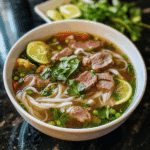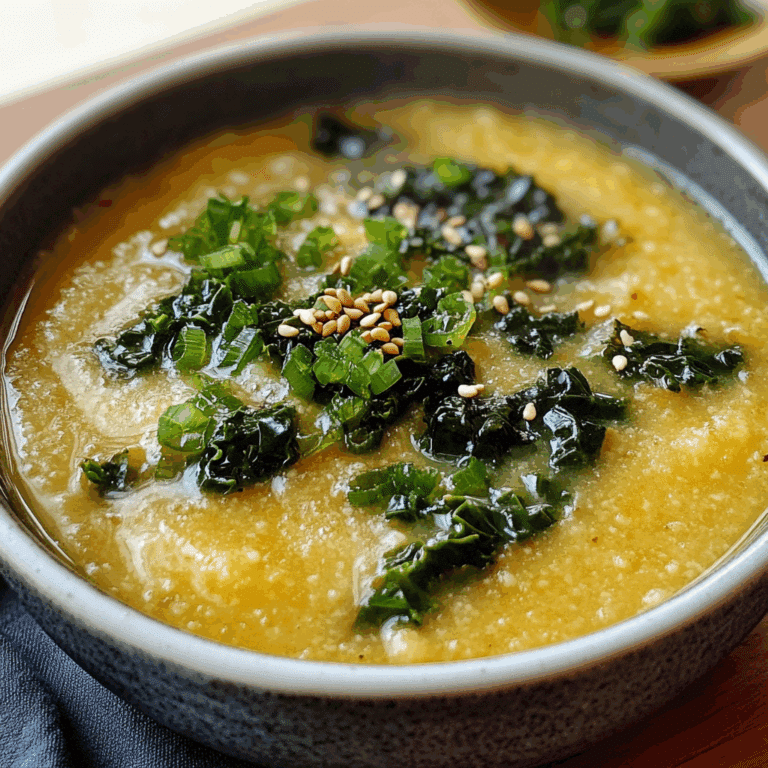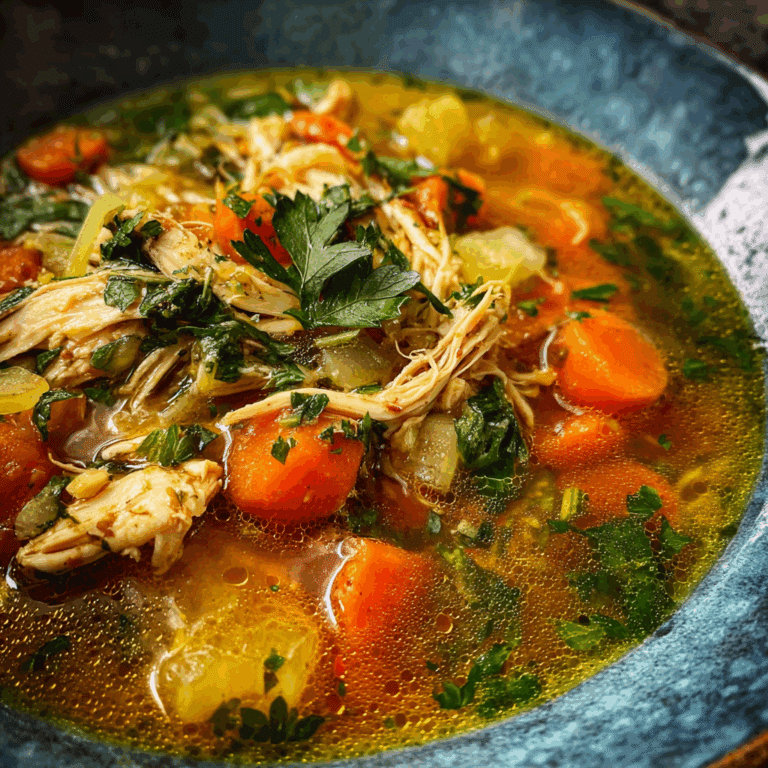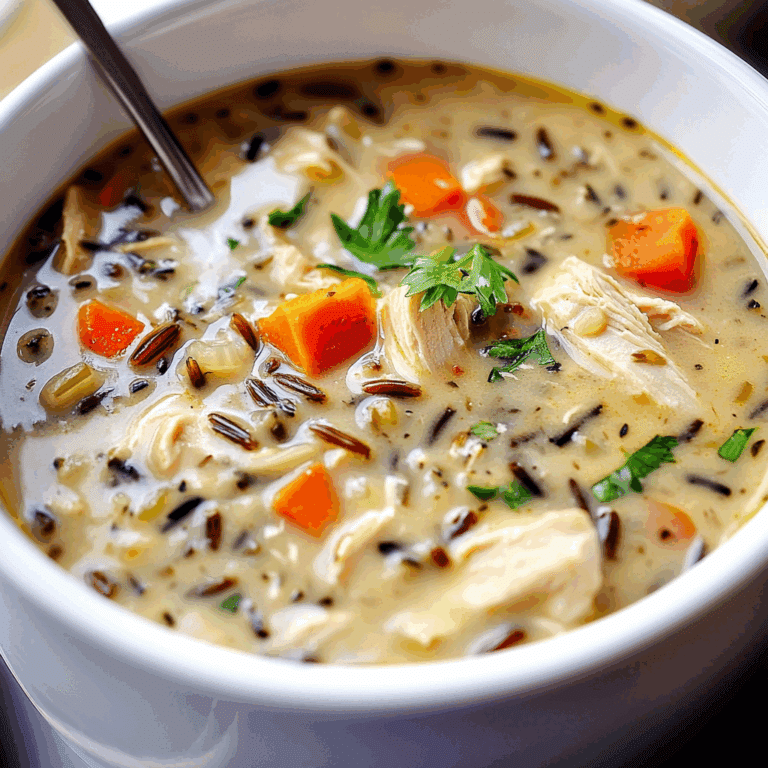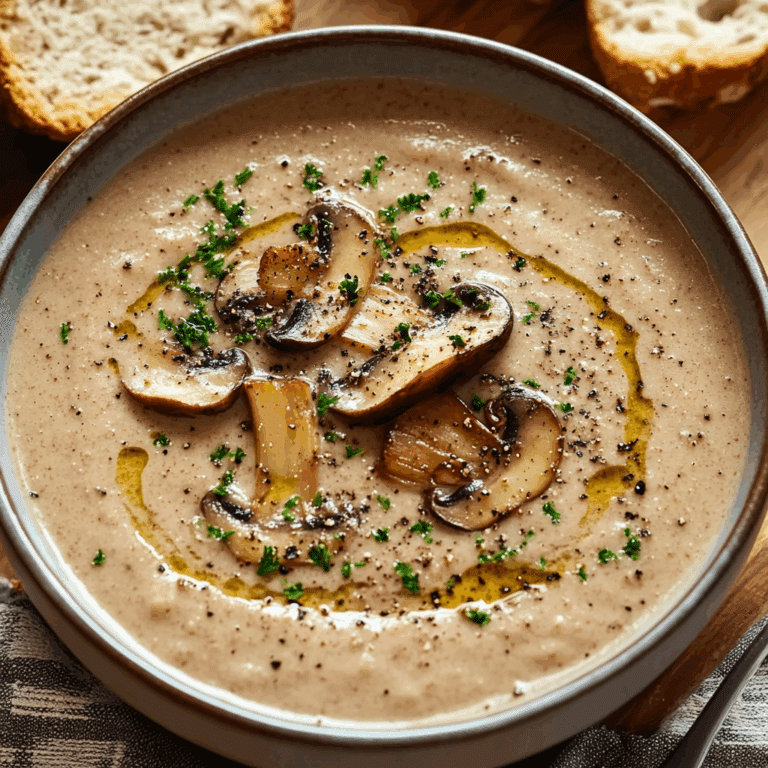Why Pho (Vietnamese Noodle Soup) Is So Irresistible
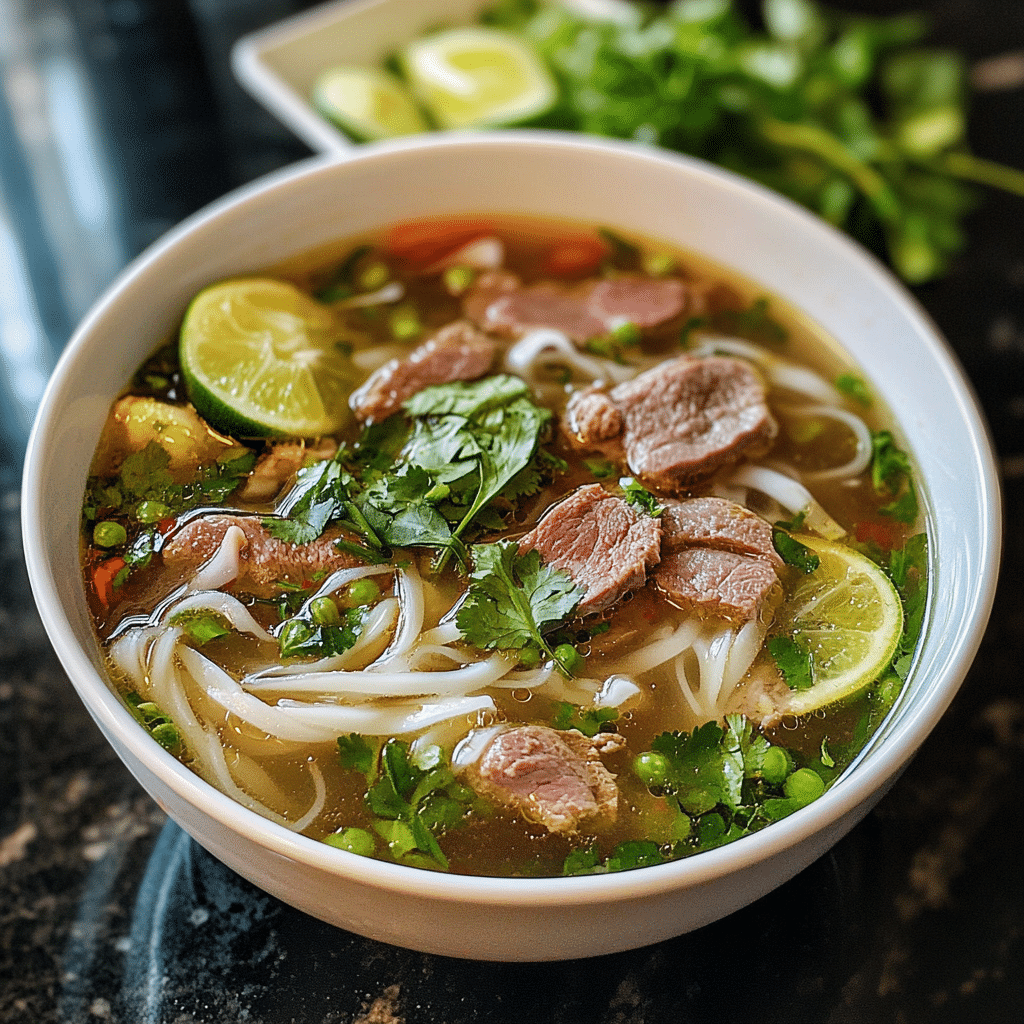
Pho (Vietnamese Noodle Soup) is a heartwarming dish that brings together fragrant herbs, tender noodles, and a deeply savory broth into a bowl of pure comfort. Loved across the globe, this iconic Vietnamese soup combines simple yet powerful ingredients that create layers of flavor, offering a soothing warmth that feels like a culinary hug on chilly days. Whether you’re new to Pho or a longtime fan, there is something truly irresistible about this dish that effortlessly balances freshness, spice, and richness.
Why You’ll Love This Recipe
- Flavorful Broth Magic: A slow-simmered broth bursting with sweet spices and savory depth invites you to savor every sip.
- Fresh and Vibrant Herbs: The fresh herbs and lime add a crisp brightness that perfectly complements the rich broth.
- Comfort in Every Bowl: Pho (Vietnamese Noodle Soup) offers a nourishing, warm meal that satisfies both body and soul.
- Quick to Customize: You can easily tweak proteins and spice levels, making it perfect for any taste or diet.
- Textural Harmony: The silky rice noodles paired with tender meat and crunchy toppings create an unforgettable mouthfeel.
Ingredients You’ll Need
Creating an authentic Pho (Vietnamese Noodle Soup) might seem complex, but the key ingredients are straightforward and purposeful—each one enhancing the broth’s aroma, the noodles’ texture, or the dish’s overall appeal.
- Beef Bones and Meat: Essential for crafting a rich, flavorful broth that forms the dish’s foundation.
- Rice Noodles: Soft yet chewy, these noodles soak up the broth’s flavor beautifully.
- Star Anise and Cinnamon: Signature spices that infuse the broth with sweet warmth and depth.
- Onions and Ginger: Roasted or charred to add smoky nuances to the broth.
- Fresh Herbs: Thai basil, cilantro, and green onions bring brightness and freshness.
- Bean Sprouts and Lime: Provide crunchy texture and zesty punch at the table.
- Fish Sauce: Adds an umami boost that rounds out the salty-sweet flavor profile.
- Chilies and Hoisin Sauce: Offer customizable spice and sweetness to taste.
Variations for Pho (Vietnamese Noodle Soup)
This Pho (Vietnamese Noodle Soup) recipe is incredibly versatile, allowing you to tailor it to your preferences or dietary needs with just a few smart swaps or additions.
- Vegetarian Pho: Use vegetable broth and tofu or mushrooms instead of beef to create a hearty plant-based version.
- Chicken Pho: Substitute beef bones and meat with chicken parts for a lighter, equally delicious alternative.
- Spicy Kick: Add fresh chili slices or sriracha for those who love a fiery twist on traditional Pho.
- Seafood Pho: Use shrimp or fish alongside a light seafood broth for a coastal-inspired flavor.
- Low-Carb Option: Swap rice noodles with spiralized zucchini or shirataki noodles to make it keto-friendly.

How to Make Pho (Vietnamese Noodle Soup)
Step 1: Prepare the Broth
Start by blanching beef bones and meat to remove impurities, then roast ginger and onions until lightly charred to enhance their smoky aroma. Simmer the bones with star anise, cinnamon, and spices for several hours, allowing all flavors to meld into a rich, clear broth.
Step 2: Cook the Noodles
Meanwhile, soak the rice noodles in warm water until pliable, then briefly boil them for that perfect tender-chewy texture that is trademark to Pho.
Step 3: Assemble the Bowl
Place cooked noodles into a deep bowl, layer thinly sliced beef or your choice of protein on top, then ladle the hot broth over to gently poach the meat.
Step 4: Garnish and Serve
Finish with a generous handful of fresh herbs, bean sprouts, lime wedges, and optional chili or hoisin sauce so each eater can customize their bowl exactly how they like it.
Pro Tips for Making Pho (Vietnamese Noodle Soup)
- Simmer Low and Slow: Keep the broth simmering gently to maintain clarity and maximize flavor depth.
- Char Your Aromatics: Roasting ginger and onions brings a beautiful smoky edge that sets authentic Pho apart.
- Slice Meat Thinly: Use a very sharp knife to slice beef paper-thin so it cooks quickly in the hot broth.
- Fresh is Best: Always serve with fresh herbs and lime to brighten and balance the broth’s richness.
- Don’t Skip Skimming: Regularly skim foam and fat off the simmering broth for a cleaner taste and clearer appearance.
How to Serve Pho (Vietnamese Noodle Soup)
Garnishes
The magic of Pho (Vietnamese Noodle Soup) lies in its garnishes like fresh Thai basil, cilantro, thinly sliced jalapeño, bean sprouts, and lime wedges—allowing everyone to tailor brightness, spice, and crunch with each bite.
Side Dishes
Common sides such as fresh spring rolls, crispy fried shallots, or a light Vietnamese salad provide contrast and complement the soup’s rich, savory qualities.
Creative Ways to Present
Try serving Pho in individual mini pots for a fun tabletop experience or layering ingredients in glass bowls showing off colorful herbs and noodles to thrill your guests visually as well as gastronomically.
Make Ahead and Storage
Storing Leftovers
Store leftover broth separately from noodles and meat in airtight containers in the refrigerator to keep ingredients fresh and prevent the noodles from becoming mushy.
Freezing
Broth freezes exceptionally well—just cool completely and freeze in portions, ready to thaw and enjoy any time you crave a comforting bowl of Pho (Vietnamese Noodle Soup).
Reheating
Gently reheat broth on the stove until steaming hot, then add noodles and meat only when serving to keep textures intact and flavors vibrant.
FAQs
What is the difference between Pho and other noodle soups?
Pho stands out due to its slow-simmered aromatic broth infused with star anise and cinnamon, accompanied by fresh herbs and rice noodles, creating a uniquely fragrant and balanced profile.
Can I make Pho (Vietnamese Noodle Soup) vegetarian?
Absolutely! Substitute the meat and bones with mushrooms, tofu, and vegetable broth to maintain rich, satisfying flavors without animal products.
How long does it take to make authentic Pho?
Traditional Pho broth requires several hours of simmering (typically 3 to 6) to develop deep flavor, but quick versions can be made with store-bought broth and shortcuts for faster prep.
What kind of noodles are used in Pho?
The soup uses flat, thin rice noodles called bánh phở, which are light, slightly chewy, and perfect at soaking up the broth.
How do I store leftover Pho?
Separate broth, noodles, and meat before refrigerating in airtight containers to prevent sogginess; broth can also be frozen for longer storage.
Final Thoughts
Pho (Vietnamese Noodle Soup) is more than just a dish; it’s a celebration of vibrant flavors, comforting warmth, and cultural tradition all in one bowl. Whether you’re enjoying a quiet night in or sharing with friends, making Pho at home offers a rewarding experience filled with delicious aromas and fresh ingredients. Dive in and savor every spoonful—you just might find your new favorite comfort food.
Related Posts
- Why Curry Red Lentil Soup Is a Must-Try
- Why Creamy Corn Soup Is Perfect for Cozy Nights
- Easy Pasta Fagioli: A Hearty Meal in Minutes
Pho (Vietnamese Noodle Soup)
Pho (Vietnamese Noodle Soup) is a classic Vietnamese comfort food featuring a richly flavored, slow-simmered beef broth infused with star anise, cinnamon, and smoky roasted aromatics, served over silky flat rice noodles and tender sliced beef. Fresh herbs, lime, bean sprouts, and spices add brightness and customization to this warm, nourishing dish perfect for any occasion.
- Prep Time: 30 minutes
- Cook Time: 3 to 6 hours
- Total Time: 3.5 to 6.5 hours
- Yield: 4 servings
- Category: Soups & Stews
- Method: Simmering
- Cuisine: Vietnamese
- Diet: Gluten Free
Ingredients
Broth Ingredients
- Beef bones and beef meat (preferably marrow and knuckle bones)
- Star anise (3-4 whole pieces)
- Cinnamon sticks (1-2 sticks)
- Onions (2 medium, peeled and halved for roasting)
- Ginger (1 large piece, peeled and halved for roasting)
- Fish sauce (3-4 tablespoons)
- Water (approx. 4-6 quarts)
- Additional spices (optional: cloves, coriander seeds)
Noodles and Protein
- Rice noodles (flat, thin bánh phở style, 200-250g)
- Thinly sliced beef (such as brisket, sirloin, or eye round, 200-300g)
Fresh Herbs and Garnishes
- Thai basil (a handful)
- Cilantro (a handful)
- Green onions, sliced (2-3 stalks)
- Bean sprouts (1 cup)
- Lime wedges (2-3 limes, cut into wedges)
- Fresh chilies or sliced jalapeño (optional, as desired)
- Hoisin sauce (optional, for serving)
Instructions
- Step 1: Prepare the Broth. Start by blanching beef bones and meat in boiling water to remove impurities; discard that water and rinse bones. Roast halved ginger and onions over an open flame or in the oven until lightly charred to develop smoky aromas. In a large pot, add bones, roasted aromatics, star anise, cinnamon, and optional spices, then cover with water. Simmer gently for 3 to 6 hours, skimming foam and fat regularly, to extract rich flavors and create a clear, fragrant broth. Finish by seasoning with fish sauce to taste.
- Step 2: Cook the Noodles. Soak the rice noodles in warm water until softened but still pliable. Bring a pot of water to boil and briefly cook the noodles until tender yet chewy, about 20-30 seconds. Drain and set aside, ready to be assembled.
- Step 3: Assemble the Bowl. Place a portion of cooked noodles into a deep bowl. Layer thinly sliced raw beef or chosen protein over the noodles. Ladle the hot broth directly over the top, which will gently cook the thin slices of meat in the heat of the soup.
- Step 4: Garnish and Serve. Top each bowl generously with fresh Thai basil, cilantro, green onions, bean sprouts, and lime wedges. Offer optional hoisin sauce and fresh sliced chilies or jalapeños at the table so each person can customize their Pho to their preferred spice and sweetness levels. Serve immediately for best texture and flavor.
Notes
- Simmer the broth low and slow to ensure clarity and maximize flavor extraction from the bones and spices.
- Roasting ginger and onions adds a crucial smoky depth, setting authentic Pho apart.
- Slice beef paper-thin with a sharp knife so it cooks quickly in hot broth.
- Fresh herbs and lime are essential to brighten the rich broth and balance flavors.
- Regularly skim the broth during simmering to remove impurities for a cleaner taste and clearer appearance.
- Store broth separately from noodles and meat to prevent sogginess when refrigerating leftovers.
- Broth freezes well; cool completely before freezing in portions for future use.
- Reheat broth gently and add noodles and meat only when serving to preserve texture.
Nutrition
- Serving Size: 1 bowl (approx. 400-500 ml broth with noodles and toppings)
- Calories: 350
- Sugar: 3g
- Sodium: 850mg
- Fat: 8g
- Saturated Fat: 3g
- Unsaturated Fat: 4g
- Trans Fat: 0g
- Carbohydrates: 40g
- Fiber: 2g
- Protein: 25g
- Cholesterol: 60mg
Keywords: Pho, Vietnamese Noodle Soup, Beef Pho, Vietnamese Soup, Rice Noodles, Comfort Food, Slow Simmered Broth

